Welcome to the Summer-into-Fall edition of the Monthly Marvel Muster. Back when this was merely the August Monthly Muster, it was coming to you from a lovely cottage by a lake, but alas, the weather intervened, so now it’s a month later and I’m ensconced in a cozy coffee shop instead. Less beautiful scenery, much more reliable electricity.
The end of the summer and the beginning of the Fall have featured the first Fantastic Four ongoing in three years, the end of the Hunt for Wolverine, and a lot of death and destruction in all corners of the Marvel universe in the form of Death of Inhumans, Extermination, Infinity Wars, and Spidergeddon.
It also featured some big announcements of upcoming new series and a couple truly terrible editorial decisions.
The Return of an Iconic Team

The summer of new series pushed into Fall with four new ongoings: Fantastic Four by Dan Slott and Sara Pichelli, West Coast Avengers by Kelly Thompson and Stefano Caselli, The Punisher by Matthew Rosenberg and Riccardo Burchielli, and Asgardians of the Galaxy by Cullen Bunn and Matteo Lolli.
Slott and Pichelli’s Fantastic Four is, of course, the biggest news, as it signals the reunification of the most famous family in Marvel Comics, after three years in which Sue, Reed, their children Franklin and Valeria, and the other students of the Future Foundation were all presumed dead.
West Coast Avengers reunites the two Hawkeyes, along with a delightfully odd team including America Chavez, Quentin Quire, and Gwenpool.
And Rosenberg and Burchielli’s The Punisher replaces Rosenberg and Guiu Vilanova’s The Punisher, making it one of the few new ongoings this summer to keep some of the previous run’s creative team.
September’s only new comic, Asgardians of the Galaxy, offers a first glimpse into the post-Infinity Wars Marvel cosmic universe, along with the return of Thor’s sister Angela and a delightful last-page surprise reveal.
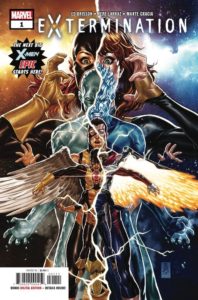
Over in miniseries, it’s all events all the time right now. After almost a year of build-up, including multiple prelude series and one-shots, Gerry Duggan and Mike Deodato Jr.’s Infinity Wars event series finally began in August. In the X-Men corner of the universe, the first three issues of Extermination by Ed Brisson and Pepe Larraz arrived, and Charles Soule and Steve McNiven seem to finally be bringing the titular character back to life in Return of Wolverine. And over in Spider-Man, the extended universe of Spider-Man characters were reintroduced in Edge of Spidergeddon, leading into the Spidergeddon event series.
Elsewhere, Mike Costa and Mark Bagley continue Marvel’s never-ending run of Venom events, miniseries and crossovers with a look at the history of the Venom symbiote in the weekly Venom: First Host, and Sina Grace returns to Iceman for a five-issue miniseries with Nathan Stockman on art.
Every Good Thing Must End
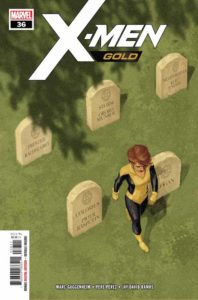
Marvel didn’t end any ongoing series in August, but made up for it with four final issues in September.
Amazing Spider-Man: Renew Your Vows by Jody Hauser and Scott Koblish quietly ended with issue #23. Renew Your Vows had a big start but was fading fairly quickly sales-wise and its end has been expected for a while.
The two bi-weekly X-Men series, X-Men Blue by Cullen Bunn and a rotating selection of artists, and X-Men Gold by Marc Guggenheim, also with various artists, each ended with issue #36. The X-Men will be back in November with a return to the classic Uncanny X-Men title. The new series will start with “X-Men Disassembled,” a weekly event written by Ed Brisson, Matthew Rosenberg and Kelly Thompson.
And Charles Soule and Angel Unzueta wrapped up their Star Wars: Poe Dameron story with issue #31. With striking Phil Noto covers, Star Wars: Poe Dameron has been a consistent seller, it’s ending not because of low sales, but because the creative team felt they’d reached the end of the story they wanted to tell.
It’s Annual Season
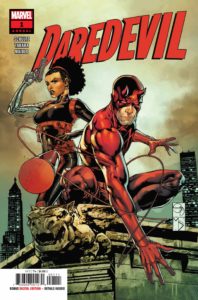
Fall is Annual season at Marvel, and they outdid themselves this year, publishing twelve Annuals in August and September.
August featured Cable and Deadpool Annual #1 by David F. Walker and Paco Diaz, Marco Rudy, Edgar Salazar & Nick Bradshaw, Spider-Man Annual #1 by Bryan Edward Hill and Nelson Blake II with Mark Bagley, Daredevil Annual #1 by Erica Schultz, Astonishing X-Men Annual #1 by Matthew Rosenberg and Travel Foreman, X-Men Gold Annual #2 by Seanan McGuire and Marco Failla, and Star Wars: Poe Dameron Annual #2 by Jody Houser and Andrea Broccardo.
Notably, two of those Annuals are for books that don’t currently exist. Cable and Deadpool haven’t shared a title since 2015’s Deadpool & Cable: Split Second miniseries, and Spider-Man Annual #1 stars Miles Morales, whose solo book under that title ended in May.
Miles’s new solo book has since been announced, but based on Cable’s current role in Extermination, he is unlikely to be headlining anything anytime soon.
The Annuals continued in September with Captain America Annual #1 by Tini Howard, Chris Sprouse and Ron Lim, Amazing Spider-Man Annual #1 by Saladin Ahmed and Garry Brown, Silver Surfer Annual #1 by Ethan Sacks and André Lima Araújo, Old Man Logan Annual #1 by Ed Brisson & Ryan Cady and Simone Di Meo and Hayden Sherman, Domino Annual #1 with stories by Gail Simone, Fabian Nicieza, Dennis Hopeless and Leah Williams and art by Victor Ibanez, Juan Gedeon, Natacha Bustos, and Leonard Kirk, and Star Wars: Doctor Aphra Annual #2 by Si Spurrier and Caspar Wijngaard.
Once again, Silver Surfer doesn’t currently have his own series, but he’s since been announced as one of the possible members of the new Guardians of the Galaxy lineup when Donny Cates and Geoff Shaw’s take on the team debuts in January.
The Cancellation of The Vision
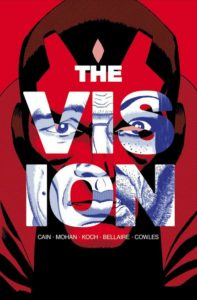
When I said Marvel had made a couple of truly terrible editorial decisions, I wasn’t exaggerating.
In July, Marvel made the exciting announcement that writer Chelsea Cain was returning to Marvel for the first time since the cancellation of Mockingbird and the subsequent harassment campaign that drove her off of Twitter. The Vision, co-written by Cain and Marc Mohan, with art by Aud Koch, was a planned six-issue follow-up to Tom King and Gabriel Walta’s Eisner-winning run of the same name.
The announcement generated a lot of buzz and positive press, with the first issue featuring prominently in Marvel’s November solicitations. And then, on September 13th, Marvel announced in their weekly email to Diamond Comics Distributors that The Vision had been canceled and would not be re-solicited.
According to Cain, four issues of The Vision had already been completed at the time of its cancellation. They were to be Aud Koch’s big break with Marvel. Now none of them will be published. The unofficial reason is that the planned series didn’t fit with the company’s new plans for the characters.
While it’s sadly not unusual for a comics company to jerk their freelancers around like this, Marvel miscalculated if they thought they had the leverage to keep this situation from turning into a public relations nightmare.
Cain is primarily a novelist, her career and livelihood is not dependent on maintaining a good relationship with Marvel, and in the hours and days following the announcement she made it clear she had no interest in keeping it “clean and quiet.” Chelsea Cain is rightfully angry. Angry on her own behalf, but also on behalf of her co-creators on The Vision, and all the other freelancers in the comics industry who can’t afford to speak up when something like this happens to them.
The Firing of Chuck Wendig
The furor over The Vision barely had time to die down before another editorial decision brought more unwanted attention to Marvel.
On October 12th, author Chuck Wendig announced on Twitter that he had been fired from Marvel, removed as the writer for two Star Wars series: the Shadow of Vader mini-series which had just been announced at New York Comic Con and for which he’d already completed his first three scripts, and a project that hadn’t yet been announced.
Wendig has been a victim of targeted online harassment for years, starting when he introduced a gay character into the Star Wars universe in the tie-in novel Star Wars: Aftermath in 2015. Despite the harassment, he has remained consistently outspoken on the internet, regularly garnering attention for his passionate and often profanity-laden tweets about US politics.
According to Wendig he was told that he was fired “because of the negativity and vulgarity that [his] tweets bring.” While it’s true that some of Wendig’s tweets can certainly be described as both “negative” and “vulgar,” that’s nothing Marvel shouldn’t have already known when they hired him. The tone of his Twitter has been consistent for years. The only thing that changed was that the angry accounts that had been yelling at him for years suddenly started yelling at Marvel too.
Another Young Hero Returns
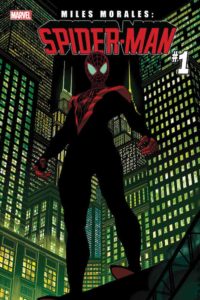
Back in the summer, I expressed concern that many of Marvel’s books starring popular young heroes had ended with no replacements announced. Happily, that continues to change.
In addition to previously announced new solo series for Riri Williams, Nadia Van-Dyne, Shuri and Spider-Gwen, Marvel have now announced Miles Morales’s next book will be Miles Morales: Spider-Man by Saladin Ahmed and Javier Garrón, premiering in December.
The Girls Are Back In Town

Two of Marvel’s highest profile female heroes will once again have solo series starting in January, both by female writers, and one with a female artist as well.
Ahead of the highly anticipated Captain Marvel movie, Kelly Thompson and Carmen Carnero have been announced for Carol Danvers’s newest solo series. When Captain Marvel #1 comes out, Thompson will be writing four ongoing books for Marvel, including two of Marvel’s highest-profile female heroes, and co-writing the return of Uncanny X-Men, making her one of Marvel’s busiest writers. Carnero’s past Marvel work includes being the first female artist to draw the Punisher’s ongoing series, and a recent arc on X-Men Red with Tom Taylor, but this is her first time as artist on a brand new series.
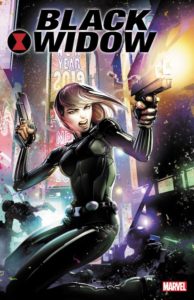
Sisters Jen and Silvia Soska, best known for writing and directing low-budget horror movies, will be writing Black Widow—Natasha Romanova’s first solo series since spring of 2017, with art by Flaviano. The Soskas have written two one-off stories for Marvel, but this will be their first ongoing comics work. I’m not a horror fan, and the series’s promise to “weave a web of vice, violence and vengeance,” makes me think it’ll probably not be my kind of book, but it’s great to see Natasha finally getting an ongoing series not written by a man, and I hope it does well.
Does the Dog Die?
In addition to blowing up New Arctilan along with its 4000+ inhabitants, Donny Cates and Ariel Olivetti have so far killed off several prominent characters in Death of Inhumans including Lockjaw the teleporting dog.
As is often the case with big events, whether or not all those Inhumans are actually dead remains decidedly up in the air, but the heartbreaking covers that have been released for November’s Death of Inhumans #5 suggest that Lockjaw’s death might just be genuine.
Pending Death of Daredevil

Charles Soule’s long run of Daredevil will be coming to a close this fall with the four-part “The Death of Daredevil” arc published bi-weekly in October and November, with art from Phil Noto.
Killing off prominent heroes is a tired trope Marvel is particularly fond of. Just in the last few years Iron Man, Black Widow, Wolverine, the Hulk, and the adult Cyclops have all been dead, brain-dead, or presumed-dead. Every one of them except Cyclops is now alive again, and Marvel have started teasing his potential resurrection as well.
When Heroes Go Bad
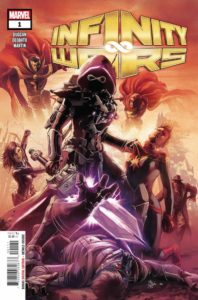
If a comics hero isn’t popular enough for a prominent death they can still get some extra attention by the simple expedient of stopping being heroes.
Best known as a frequent member of the Guardians of the Galaxy, Gamora has recently taken a turn for the villainous, wielding the Infinity Stones as Requiem in the ongoing Infinity Wars event.
Namor the Sub-Mariner has been both a hero and a villain many times since his 1939 debut, but has mostly settled into the role of cantankerous anti-hero of late, appearing fairly prominently in a number of X-Men series, most recently X-Men Red. That’s changing now. Namor will once again be declaring war against the surface world this month in Jason Aaron and David Marquez’s Avengers, and come January his WWII-era teammates will be teaming up to stop his “deadly plans” in Invaders from Chip Zdarsky, Carlos Magna, and Butch Guice.
Marvel 80th Anniversary Celebration
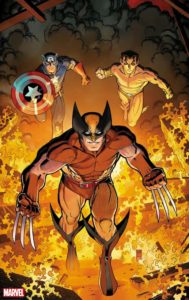
Zdarsky, Magna, and Guice’s Invaders is going to be part of Marvel’s year-long celebration of their 80th Anniversary. Other plans include one-shots for long-defunct titles Crypt of Shadows, Journey Into Unknown Worlds, and War is Hell, and the return of the classic anthology series Marvel Comics Presents.
August and September Highs and Lows
Fantastic Four #1
Simone Bianchi (artist), Elisabetta D’Amico (inker), Marte Gracia (color artist), Sara Pichelli (artist), Marco Russo (color artist), Dan Slott (writer), Jeremy Treece (color artist), Skottie Young (artist)
Marvel Comics
August 8, 2018
[Guest Review by Elizabeth Holden. Elizabeth has been reading Marvel comics since the fateful day she picked up Fantastic Four #18 at a corner store in 1963. I asked for her thoughts as an old Fantastic Four fan on the first issue of the team’s newest series.]
“Band of explorers” is how Ben Grimm describes the Fantastic Four on the first page of the new Fantastic Four. I like that approach: the FF began in 1961 with a story about an attempt to explore the moon. Fifty-seven years later, we have another first issue (#1, but also “Legacy #646”) with a story in which exploration has broken up the team, and is bringing them together again.
They’ve come a long way since 1961, in a comic subtitled with Stan Lee’s classic overstatement, “The World’s Greatest Comic Magazine.” Sometimes the title has lived up to this ambition, sometimes far from it. With two unimpressive movies, no marketing presence, and a three-year hiatus in publication, lately the FF has hardly been a high point of the Marvel comics line-up.
So I hoped for something good, or halfway to great, or at least acceptable, from the new Slott/Pichelli team. What I got was neither stellar nor disappointing, but a good reintroduction to the familiar and beloved team.
The situation: Reed Richards and Sue Storm are somewhere in interplanetary (and literary) limbo, while Ben and Johnny Storm, back on earth, search for them and wait for their return. Ben believes Reed and Sue to be dead, but pretends he doesn’t, to keep Johnny’s spirits up. Kids in the Yancy Street Gang, an echo of Ben’s early past, steal and set off the Fantastic Four flare gun as a prank, bringing the FF again to the forefront of the news and everyone’s thoughts. This brings Ben to a life-changing decision: to marry Alicia, the love of his life; and Johnny to accept that his sister and brother-in-law and their children are dead and never going to return.
Except, of course, they aren’t. In some distant place, Reed (again) attempts the impossible… to come home. And this time, he is successful, as shown by the real Fantastic Four flare symbol in the sky.
This comic delightfully recaptures the sense of wonder, the humour, and the humanity that has always been the hallmark of the Fantastic Four at its best. Everyone is beautifully in character. Ben Grimm is funny and sad, Johnny Storm brash and determined, Alicia sweet and understanding. The scene of Ben Grimm holding four kittens is a highlight. There are some great cameos with Jennifer Walters, the Inhumans, and Luke Cage. An odd digression to an adventure of their past establishes a new tweak to the canon: that Johnny sings beautifully, and Sue does not.
Which shows that Dan Slott understands these characters particularly well, in both style and spirit.
Were there disappointments here? Two. First, though the character’s emotions are intense, the plot itself is not; we don’t get, in this first issue, the pay-off of the Fantastic Four reuniting. The “4” symbol in the sky is weaker than the image of the clasped hands on arms by which the team first proclaimed their solidarity all those years ago: tactile, definitive, and personal. The writers themselves acknowledge that the end is unsatisfying, in the Impossible Man’s appearance in an epilogue on the final page: even Impy complains that we have to wait for the next issue for the actual reunion.
I wanted something punchy, and I got something that was reflective and sweet.
The second disappointment is the inclusion of a Dan Slott/Simone Bianchi short story about Doctor Doom—a setup for his later appearances, no doubt. Though it is unobjectionable in itself, it was out of place and broke the sense of warm satisfaction the previous story should have left us with.
But there was so much that was satisfying that the disjointed mood can be forgiven. Johnny as a sports fan and girl-magnet; Ben saying “no comment” to the press about his team; Ben hiring the defense for the Yancy Street boys; Ben wanting Johnny to be the best man at his wedding; Johnny’s adamant refusal; and Luke Cage’s whispered “Sweet Christmas!” at the end. Ben Grimm’s proposal of marriage to Alicia has been fifty years in the making, and forms a wonderful climax to a story based on relationships and feelings.
The layouts and panel compositions were outstanding. My favourites: the one-panel, two-panel, four-panel juxtaposition in the first three pages of Ben’s shopping with Alicia, and Johnny at a baseball game with Wyatt Wingfoot – and it’s good to see him again, too.
Like the Impossible Man, I will be reading the next issue with anticipation.
Luke Cage #1

Clayton Cowles (letterer), Anthony Del Col (writer), Ian Herring (color artist), Jahnoy Lindsay (artist)
Marvel Comics
August 15, 2018
I really wanted to like this comic.
I really didn’t like this comic at all. I found the plot stale and unoriginal, the art unnecessarily gruesome in places and weirdly flat in others, and Luke Cage’s behaviour completely out of line with how I’d expect any parent to behave.
A heat-wave has hit New York City, Jessica Jones is out of town, Danielle Cage is getting sick, and Luke Cage isn’t feeling all that well himself. Oh, and someone is sending millionaires with questionable pasts notes scrawled on dollar bills threatening their lives. Within 24 hours of receiving the notes the recipients die by projectile vomiting implausible amount of blood. Which is a scene I really only needed to see on page at most once, but Del Col and Lindsay felt it necessary to repeat.
The representatives of the discontented masses murdering the rich was last a fresh plot about the time of the French Revolution, and Del Col and Lindsay further weaken it by making their rich victims suspiciously overly-sympathetic figures.
And just in case one clichéd plot wasn’t enough, Luke Cage includes every writer’s favourite plot of the year: due to repeated head injuries as a superhero, Luke Cage apparently has Chronic Traumatic Encephalopathy (CTE).
CTE and its relationship to violent sports and activities is an important issue of our time, but attempting to address it in a superhero universe is a mistake. If Luke Cage has CTE, so does nearly every other hero or villain in comics. Someone might be able to make a great comic about that, but it won’t be at Marvel or DC.
But none of that is my biggest problem with this issue. The really unforgivable part is that Luke Cage is a really terrible father, in a way that can’t be explained away by CTE. Luke is walking down the street with Danielle when he realizes they’re being followed by a car. A man he’s never met before gets out to talk to him, and upon seeing Danielle says, “oh, is your daughter sick?” explains that he works in healthcare, and puts out his arms. At which point Luke just hands the guy his sick kid.
I’m not even a parent, only an aunt, and great-aunt, but I positively recoiled at that scene. I wouldn’t hand a child in my care over to any passing stranger and I’m NOT a famous superhero and regular target of villainous plots against myself and my family.
Besides objecting to the unnecessarily repeated projectile vomiting scenes, I found Jahnoy Lindsay’s pencils flat and lacking in energy. Luke has the same facial expression in almost every scene, and even when he’s in motion he looks like he’s standing still. I’m normally quite fond of Ian Herring’s color work, but here it can’t get past the weaknesses of the art. Scenes with minimal shading and empty backgrounds just aren’t that interesting, no matter how beautiful the colors.
West Coast Avengers #1

Joe Caramagna (letterer), Stefano Caselli (artist), Triona Farrell (color artist), Kelly Thompson (writer)
Marvel Comics
August 22, 2018
This, on the other hand, I adored. In West Coast Avengers, Thompson and Caselli embrace the inherent ridiculousness of superheroism, while keeping true to the depth of the characters and their relationships.
The two Hawkeyes are reunited, and now they’re running a superhero team. Well, Kate’s running the team. Clint’s mostly just there for in-universe name recognition, banter and telling Kate she’s got this.
Which she probably does. If by “this” you mean, two extremely powerful characters with strong and clashing personalities, one seriously loose cannon, her boyfriend who’s never done the superhero gig before, and Clint. Oh, and a documentary camera crew filming them all Big Brother-style.
Putting Quentin Quire, America Chavez and Gwenpool on the same team and in the same house is comedic genius, made particularly great by the fact that their powers would actually work fairly well together if Kate could ever get them pointed in the same direction at the same time. And the confessional-style interviews of the characters, which I was uncertain of as a concept, are used in a skilled and limited way to enhance the plot rather than to overwhelm it.
Caselli’s art is playful and detail-rich, with a particularly great feel for facial expressions and body language. Caselli’s art tends towards the naturalistic rather than the fantastic, and that works well for this book, where a more over-the-top art style would overwhelm the already over-the-top plot.
Triona Farrell’s colours are subtle and crisp in a way that serves Caselli’s art well, and really captures the look and feel of L.A. The climactic fight scene on a beach at sunset is particularly well-coloured, a palette of oranges and reds that’s so true to life that it made me homesick for the Pacific coast.
Asgardians of the Galaxy #1
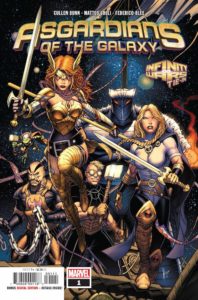
Federico Blee (color artist), Cullen Bunn (writer), Matteo Lolli (artist), Cory Petit (letterer)
Marvel Comics
September 5, 2018
I always say I don’t really care about Marvel’s cosmic titles, but I’m tentatively making an exception for Cullen Bunn and Matteo Lolli’s Asgardians of the Galaxy, an uneven but so-far fairly compelling story. The types of stories Bunn is interested in writing and the types of stories I’m interested in reading only occasionally overlap, but when they do I find him to be wonderfully fun to read.
Resentful of the attention her sister Gamora is getting over in Infinity Wars, Nebula has come up with a plan to summon an armada of dead gods to wage war against the galaxy. Angela of Heven, daughter of Odin and a serious powerhouse even by Asgardian standards, has put together a secret team to stop her.
The Asgardians of the Galaxy are the type of team for which the term “motley crew” was invented. Angela herself, Skurge the Executioner, Thunderstrike, dudebro wielder of Asgardian weaponry, Throg, Frog of Thunder, and human archaeologist Annabelle Riggs, who since Bunn’s short run on Fearless Defenders has shared a body with the Asgardian warrior Valkyrie. Oh, and some mysterious figure wielding the Asgardian Destroyer armor, but Angela’s the only one who knows who that is and she won’t say. Honestly, the two most consistently heroic characters on the team are the non-powered human and the frog.
The setup was great, but I found the actual story uneven. The opening scene of Angela and Skurge interrupting Annabelle’s date with her Inhuman girlfriend Ren Kimura is delightful, but the choice to tell the rest of the story non-linearly, jumping back and forth between the team’s first big battle with Nebula, and their first meetings on Angela’s ship was needlessly confusing and didn’t actually add to the dramatic tension in any meaningful way.
I found Matteo Lolli’s art similarly uneven. Some scenes, such as Annabelle and Ren’s date, and the last-page reveal of who exactly is behind the Destroyer are excellent, but others feel generic and lacking in nuance. Also, every single female character has almost the exact same face.
Still, I’m willing to give this one at least one more issue.
Iceman #1

Federico Blee (color artist), Sina Grace (writer), Joe Sabino (letterer), Nathan Stockman (artist)
Marvel Comics
September 12, 2018
Sina Grace’s Iceman ongoing was profoundly uneven, but I ultimately liked it enough that I was looking forward to his return to the character. Unfortunately, I found this first issue of what is to be a five-issue miniseries incredibly disappointing and derivative.
I’ve read this exact story a dozen times. Bobby Drake in an odd-couple team-up with a notoriously humourless fellow hero. An attempted massacre of the Morlocks living under New York City. And an entirely too predictable villain secretly masterminding it all. If it weren’t for Bobby flirting with boys and a clumsy reference to the Dark Web, this story could have been written anytime in the last thirty years.
Nathan Stockman’s pencils and Federico Blee’s colours would fit right in to an issue of X-Force circa about 1992. Add in Bobby’s co-star, the quintessential 90s hero Bishop, in almost the exact same uniform he wore back then, and the atmosphere of forced nostalgia becomes overwhelming.
The 90s throwback feel is clearly intentional, and aimed right at older fans with a lot of nostalgia for that era. I love the 1980s Chris Claremont and Louise Simonson-era X-Men stories. But a story that was cutting-edge in 1986 is tired and predictable today. And while I will always have a place in my heart for early 90s X-Force, art that would have been fresh and exciting in 1992 looks hopelessly old-fashioned and garish in 2018.
The Life of Captain Marvel #3

Clayton Cowles (letterer), Rafael Fonteriz (inker), Marcio Menyz (color artist), Carlos Pacheco (penciler), Marguerite Sauvage (artist), Margaret Stohl (writer)
Marvel Comics
September 19, 2018
I’ve been holding off on reviewing this miniseries until I had a better idea where it was going. When you market a series as “the true origin” of a character who’s been a superhero since the 70s, I get nervous. When you market a series as revealing “the definitive origin” of a character whose origin story has already been successfully retconned and streamlined once this decade (by Kelly Sue DeConnick and Dexter Soy in Captain Marvel in 2012), I can best be described as “dubious.”
But Margaret Stohl showed a good understanding of Carol’s character in her solid, though somewhat uninspired, run on The Mighty Captain Marvel, and Carlos Pacheco is one of the best artists in the business for straight-up superhero stories, so I was willing to give The Life of Captain Marvel a shot, and I’m glad I did.
Visiting her family’s summer home in Maine, Carol is attempting to reconnect with her mother and brother Joe, flirt with an old friend, and face down memories of her abusive father and the secrets her parents kept from her. Also, her brother has been in a coma since issue #1, after he got in an argument with Carol and then a car accident. Oh, and there’s a deadly Kree assassin racing straight for them.
It’s a lot, and I won’t pretend it doesn’t take a bit too much of a turn towards melodrama at times, especially the whole brother in a coma angle, but it mostly works because, like most great superhero stories, it is at heart a very personal story.
Growing up in an abusive household casts a long shadow, and everybody who was there experienced it differently, remembers it differently, and has their own reasons for why they did or did not stay. And for all the fantastical elements, the slowly-revealed reasons behind the different choices and decisions the different members of the Danvers family made, feel all too real.
As for that “true origin” story? It’s not at all what I expected, and I’m liking it quite a lot. DeConnick and Soy’s reworking of Carol’s superhero origin worked because it forefronted the women who came before her and influenced her life. The Life of Captain Marvel so far works equally well by putting the focus on the woman who influenced Carol’s pre-superhero life more than any other, and about whom she has the most conflicted feelings: her mother.
Pacheco, Fonteriz and Menyz’s bright modern-day superheroics and Marguerite Sauvage’s more sepia-tones flashbacks work well together, showing a clear distinction between the past and present, but with enough similarity for the transitions not to feel jarring. Also, Julian Totino Tedesco’s covers for this serious are incredibly gorgeous and eye-catching. I want to frame them all and hang them on my walls.
The Unbeatable Squirrel Girl #35

Derek Charm (artist), Travis Lanham (letterer), Ryan North (writer), Rico Renzi (color artist)
Marvel Comics
August 8, 2018
One of the many delightful running plots in The Unbeatable Squirrel Girl has been Doreen Green’s unlikely friendship with Kraven the Hunter. What started as a joke has turned into a remarkably nuanced relationship. But, as often happens when supporting characters appear in multiple books with markedly different tones, the Kraven Doreen Green knows is not the Kraven the rest of the Marvel universe experiences, and that was bound to catch up with him eventually.
And catch up to him it did, in July’s The Unbeatable Squirrel Girl #34 where an awkward arrest forced Doreen to confront the reality of her friend Sergei’s villainous past (and present), and Kraven ended up once again on the run from the law, this time with Squirrel Girl as well as most of the NYPD in hot pursuit.
In issue #35 a new player character enters the chase, the friendly neighborhood Spider-Man, and considering Kraven’s history with Spider-Man, things can only go south from there.
The reformed, or temporarily reformed villain is a popular trope, but North forces his characters to confront exactly how difficult that kind of redemption is to earn. If Kraven is going to change, he needs to take actual responsibility for the past choices he’s made, and Doreen needs to let go of her overly-rosy view of her friend and acknowledge the full reality of his past actions.
Because Kraven might be Doreen’s friend, but he has attempted to kill Spider-Man more times than either of them can count, and that doesn’t go away just because he has become her friend. This is no “brainwashed Soviet assassin” situation. Kraven has made a series of wrong choices of his own free will, over and over again.
Derek Charm’s art is always delightful, but I have to say he is particularly well-suited to drawing Peter Parker. The scenes of Doreen, Kraven and Spider-Man facing off in an alley are some of the best work he’s done on this book.
Peter Parker: The Spectacular Spider-Man #308 & #309
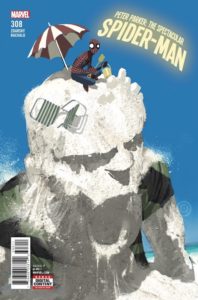
Chris Bachalo (penciler and colorist), Wayne Faucher (inker), Travis Lanham (letterer), Livesay (inker), Victor Olazabo (inker), Tim Townsend (inker), Al Vey (inker), Chip Zdarsky (writer)
Marvel Comics
August 15, 2018 and September 12, 2018
How is it that Chip Zdarsky and Chris Bachalo can make me tear up with a story about the death of Sandman of all characters? Sandman. I’m not sure I’ve ever had any kind of feeling about Sandman, positive or negative, anytime before in my life. I can’t say I’ve ever thought much about him at all. But Zdarsky and Bachalo give the story of Flint Marko’s last days—and last fight—such a fitting balance of poignancy and heroism that I couldn’t help but be moved.
Bachalo’s distinctive style works particularly well for this story, giving Sandman’s non-human form a dynamism and energy that is at times tense and menacing and at other times dorky and endearing, but is always just incredibly, wonderfully alive.
The best Spider-Man stories remember that it isn’t his superpowers that make Peter Parker a hero it’s his empathy, and his kindness. The kind of empathy that means when he finds himself at the bedside of a dying adversary, he does everything in his power to allow Sandman to face his death with dignity and peace of mind.
Seriously, they made me cry about Sandman. Who does that?!?

